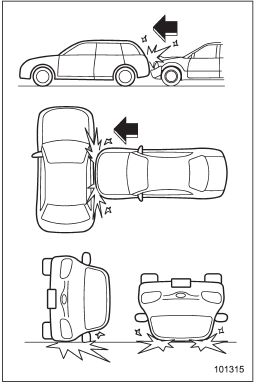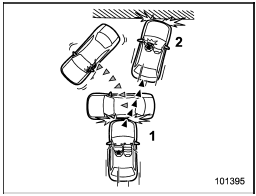Examples of the types of accidents in which the driver’s/driver’s and front passenger’s SRS frontal airbag(s) will basically not deploy.

The driver’s and front passenger’s SRS frontal airbags are designed basically not to deploy if the vehicle is struck from the side or from behind, or if it rolls onto its side or roof, or if it is involved in a lowspeed frontal collision.

1) First impact
2) Second impact
In an accident where the vehicle is impacted more than once, the driver’s and/or front passenger’s SRS frontal airbag(s) will deploy only once on the first impact.
Example: In the case of a double collision, first with another vehicle, then against a concrete wall in immediate succession, once either or both of the driver’s and front passenger’s SRS frontal airbags is/are activated on the first impact, it/they will not be activated on the second impact.
See also:
Seatbelt maintenance
To clean the seatbelts, use a mild soap and lukewarm water. Never bleach or dye
the belts because this could seriously affect their strength.
Inspect the seatbelts and attachments including the web ...
Corresponding profiles for the cell phone
• HFP (Hands Free Profile): Ver. 1.0
• OPP (Object Push Profile): Ver. 1.1 ...
Roof antenna
• Be sure to lower the antenna rod before entering garages, parking towers and other locations with low ceilings.
• Remove the antenna rod before washing your car at a car wash. If the antenna ro ...


